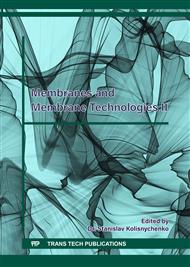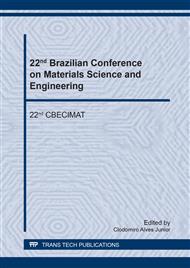p.195
p.201
p.207
p.212
p.218
p.224
p.230
p.236
p.241
Study of Hybrid Membranes Prepared with the Addition of Calcium Chloride
Abstract:
In this work, hybrid membranes were obtained with the addition of calcium chloride (CaCl2). Hybrids were obtained by the melt intercalation method. Membranes were prepared by phase inversion technique. Hybrid and hybrid membranes were characterized by differential scanning calorimetry (DSC). The DSC curve of the polymer and polymer membrane was changed by addition of the clay, increasing the degree of crystallinity. For all membranes, it was observed the existence of two endothermic peaks corresponding to the two crystalline phases of the polymer characteristics, in the range of 220 °C related to the alpha phase and, in the range of 210 °C related the gamma phase. In addition, there was the appearance of an endothermic peak at about 70 °C, related to the temperature of the dry polymer glass transition. The addition of CaCl2 changed the crystalline behavior of hybrids, becoming less evident the nucleating effect of the clay.
Info:
Periodical:
Pages:
218-223
Citation:
Online since:
September 2018
Keywords:
Price:
Сopyright:
© 2018 Trans Tech Publications Ltd. All Rights Reserved
Share:
Citation:



